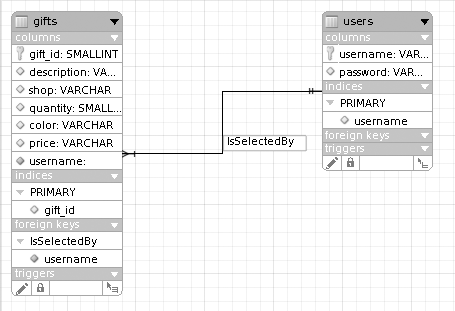Designing and Creating the Wedding Database
Let’s say Jack and Jill are getting married and would rather not receive the traditional 7 toasters and 11 electric kettles. Instead, they’ve decided to lists things they actually do want on a web site and let wedding guests select something useful to buy from the list.
Thinking about the problem carefully, we come across several requirements. Our application should:
Allow Jack and Jill to add to or modify the list of required gifts
Allow users to view the gifts that can be selected
Allow users to select gifts to buy, or to deselect gifts they have previously reserved
Not allow users to select gifts that are already reserved
Authenticate users to identify them and prevent one user modifying the selections of another
There are two entities here: users and gifts. Each user has a unique username and password, while each gift has a unique gift ID number, a description, desired quantity, color, place of purchase, and price. A gift may be reserved by a user, so each gift record can have a username associated with it. A one-to-many relationship is maintained between the two tables: each gift can be reserved by only one user; each user can reserve zero or more gifts. Figure 15-1 shows the ER model in the MySQL Workbench.

Figure 15-1. The wedding registry ER model using the MySQL Workbench
Our database needs to contains only two tables—users, which stores ...
Get Learning MySQL now with the O’Reilly learning platform.
O’Reilly members experience books, live events, courses curated by job role, and more from O’Reilly and nearly 200 top publishers.

